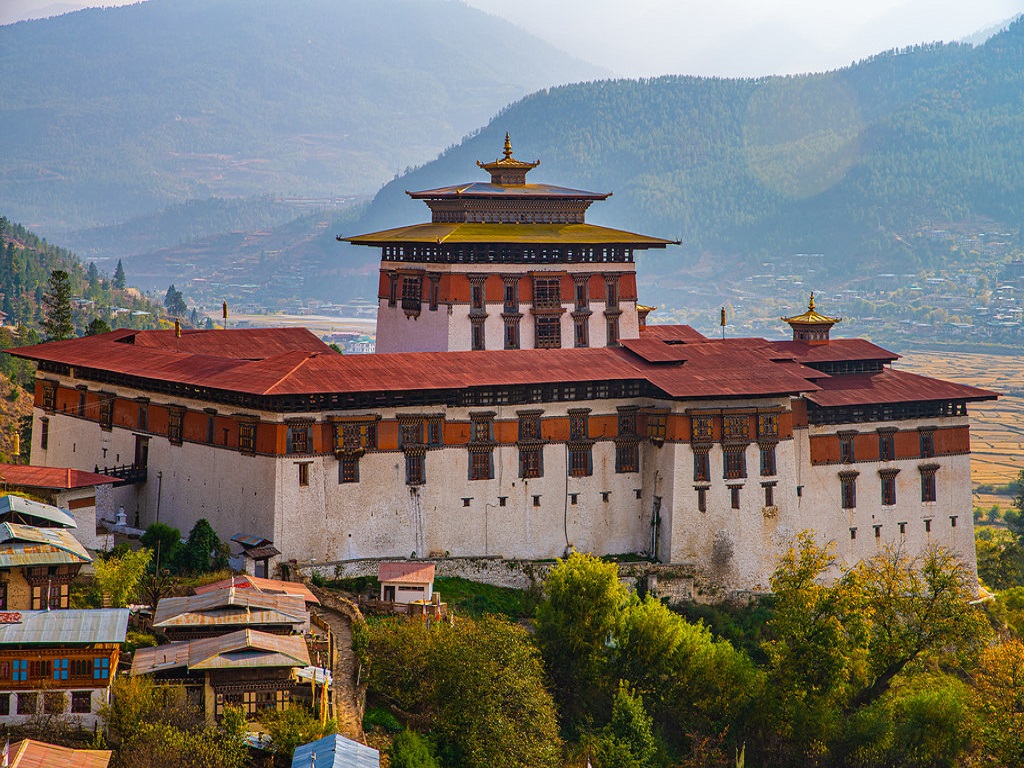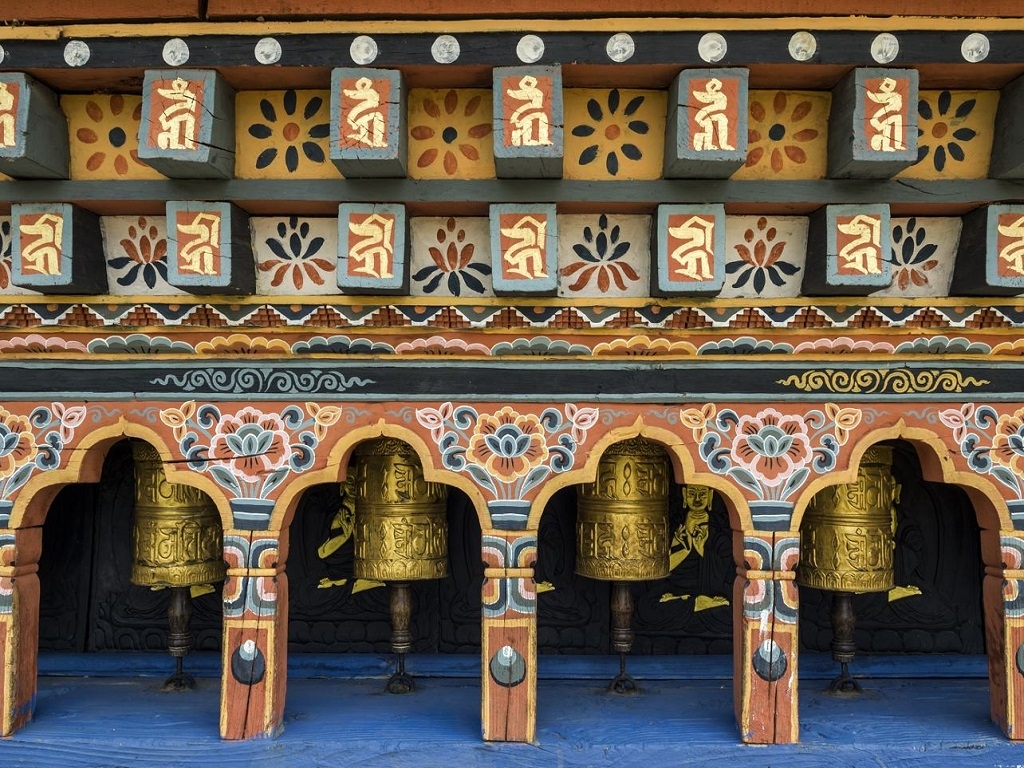Exclusive Experience
• Enjoy Takin, Bhutan’s national animal spotting
• Get to hands on Archery, Traditional Butter Tea and local rice wine sampling at Simply Bhutan
• Traditional Gho & Kira Dress-Up Session
• Celebrate With A Sense of Accomplishment & Receive A Certificate of Achievement y
• Learn to cook local dish Ema Datshi and get to taste
Specialty Meals
• 100% meals with 4 different cuisines
Paro
• Kyichu Lhakhang
• Rinpung Dzong
• Taktsang Lhakhang
• Drukgyel Dzong
Gangtey
• Gangtey Gonpa
• Phobjikha Valley
• Black-Necked Crane Visitor Centre
Punakha
• Punakha Dzong
• Chimi Lhakhang
• Dochula Pass
• Druk Wangyal Chortens
Thimphu
• Trashi Chho Dzong
• Bhutanese Crafts Bazaar
• Kuenselphodrang Nature Park
• Buddha Dordenma Statue
• National Memorial Chorten
• Motithang Takin Preserve
• Folk Heritage Museum
• Norzin Lam
• Jungshi Handmade Paper Factory

IMPORTANT NOTES
Clothes & Other Paraphernalia Communications Electricity Health Inoculations Before embarking on a trip to Bhutan, please seek advice from your doctor with regard to vaccinations and appropriate medication you should have prior to your travels. As a minimum you should have tetanus, typhoid and hepatitis A inoculations. Money Photography Shopping Time Weather Precautions
Day 1SINGAPORE – PARO

Everyday Holiday With Chan Brothers Travel.jpg.jpg

D1_RINPUNG DZONG_1.jpg.jpg

D1_RINPUNG DZONG_2.jpg.jpg

D1_KYICHU LHAKHANG TEMPLE.jpg.jpg

D1_EMA DATSHI TASTING SESSION.jpg.jpg
![]() Meals On Board / Breakfast / Lunch
Meals On Board / Breakfast / Lunch
Day 2PARO

D2_TAKTSANG MONASTERY.jpg.jpg

D2_TAKTSANG MONASTERY_TREKKING.jpg.jpg

D2_DRUGYEL DZONG.jpg.jpg

D2_GHO AND KIRA DRESS UP SESSION.jpg.jpg
Take an early breakfast and embark on a hike to Bhutan’s most iconic landmark, Taktsang Lhakhang, also known as Tiger’s Nest Monastery. It clings precariously to a granite cliff 900 metres above Paro Valley. The monastery was first built in 1692 at a cave where legend has it that the great Guru Rimpoche flew to the site atop the back of a tigress and meditated in the cave in order to subdue evil demons residing within. You may wish to take a pony ride at your own expense. Thereafter, visit Drugyel Dzong, the victory fortress built in 1647 by Zhabdrung Ngawang Namgyal to commemorate his victory over Tibetan invaders led by Mongolian warlord Gushri Khan in 1644. Wrap up your day with a Gho and Kira traditional dress-up session and flood your social media page endless feed of that cultural perfect-picture you. Note Please wear comfortable walking shoes for your hike to Taktsang Lhakhang. The hike is not recommended for pregnant women and travellers with health conditions. Accommodation: Tenzeniling Resort / The Tiger Nest Camp or similar
![]() Breakfast / Lunch / Dinner
Breakfast / Lunch / Dinner
Day 3PARO – PUNAKHA

After breakfast, head to Punakha. Along the way, cross Dochula Pass and proceed to Druk Wangyal Chortens, where the construction of 108 chortens was commissioned by the eldest Queen Mother. Next, take a light hike through fields of assorted vegetables that will take you to Chimi Lhakhang, a pilgrimage site for childless couples. Camera ready as we proceed on to Punakha Dzong, situated at the confluence of the Mo Chhu and Pho Chhu rivers. An iconic and instagrammable site. Keep that snapping fingers at the Punakha Suspension Bridge, one of the longest suspension bridges in Bhutan, before staying overnight in your hotel.
Accommodation: Punakha Bhutanese-style Unique Lodging
![]() Breakfast / Lunch / Dinner
Breakfast / Lunch / Dinner
Day 4PUNANKHA – GANGTEY – THIMPHU

Today, head into the country side towards Gangtey Gonpa, the largest Nyingma monastery in Bhutan. Then, make your way towards the Phobjikha Valley, a wide glacial valley with a central stream that meanders through thickets of dwarf bamboo. The forest beyond the farms is mostly coniferous, and the general vegetation is composed of blue pine, birch, maple and several species of rhododendron. Home to the migratory black-necked crane, the valley is one of the most beautiful spots in Bhutan. Spot these rare, gorgeous cranes during the months of late October to February as they leave the Tibetan Plateau and pass the Himalayan peaks to reach their winter grounds. Make a stop at the Black-Necked Crane Visitor Centre to learn more about the cranes. Thereafter, enjoy a picturesque ride to Thimphu for your overnight stay. Accommodation: Druk Thimphu / Ariya Hotel Thimphu or similar
![]() Breakfast / Lunch / Dinner
Breakfast / Lunch / Dinner
Day 5THIMPHU

CHIMI LHAKHANG_1.jpg.jpg

CHIMI LHAKHANG_2.jpg.jpg

TRASHI CHHOE DZONG.jpg.jpg
This morning, visit Kuenselphodrang Nature Park, where you can catch a panoramic view of Thimphu Valley and marvel at the 169-foot tall bronze Buddha Dordenma Statue, the largest statue in the country. Next, explore National Memorial Chorten, a stupa built to honour the late 3rd king, before heading over to Motithang Takin Preserve, where you can observe strangle, gentle beasts resembling goat-cow hybrids – Takin – roam within this patch of forest. See art and craft students at work on thangkas painting, woodcarving, exquisite embroidery or clay statue-making (clay) at National Institute for Zorig Chusum and commonly known as 'the painting school'. Next, visit Simply Bhutan, a living museum whose primary aim is to conserve the culture and customs of traditional Bhutanese life. Try out archery, the Bhutanese National Sport. After lunch, stop over at Jungshi Handmade Paper Factory, a pilot conservative program to preserve their traditional handmade paper making. You can observe the entire process of producing handmade paper using ancient traditional methods that have been practiced for generations. Amble through an authentic Bhutanese crafts bazaar and the bustling Norzin Lam, where you can purchase handicrafts, garments and accessories at your own expense.
Accommodation: Druk Thimphu / Ariya Hotel Thimphu or similar
![]() Breakfast / Lunch / Dinner
Breakfast / Lunch / Dinner
Day 6THIMPHU – PARO - SINGAPORE

Bid fare to the happiest on earth as you check out and proceed to Paro for your flight back home. On the way, make more memories as we cross the Tachogang Lhakhang Bridge. an iron chain bridge built by Drupthob Thangtong Gyalpo and is the access route to the famous Tachogang Lhakhang Dzong. Finish up your dollars at Paro Town Market for last minute shopping.
![]() Meals On Board / Breakfast / Lunch
Meals On Board / Breakfast / Lunch
Day 7ARRIVAL SINGAPORE

ARRIVAL SINGAPORE
![]()
Day 1SINGAPORE – PARO – THIMPHU

![]() Meals On Board / Breakfast
Meals On Board / Breakfast
Day 2THIMPHU

![]() Breakfast (breakfast) / Lunch / Dinner
Breakfast (breakfast) / Lunch / Dinner
Day 3THIMPHU – GANGTEY – PUNAKHA

Today, head into the country side towards Gangtey Gonpa, the largest Nyingma monastery in Bhutan. Then, make your way towards the Phobjikha Valley, a wide glacial valley with a central stream that meanders through thickets of dwarf bamboo. Home to the migratory black-necked crane, the valley is one of the most beautiful spots in Bhutan. Spot these rare, gorgeous cranes during the months of late October to February as they leave the Tibetan Plateau and pass the Himalayan peaks to reach their winter grounds. Make a stop at the Black-Necked Crane Visitor Centre to learn more about the cranes. Thereafter, enjoy a picturesque ride to Punakha for your overnight stay. Accommodation: Punakha Bhutanese-style Unique Lodging
![]() Breakfast (breakfast) / Lunch (lunch) / Dinner
Breakfast (breakfast) / Lunch (lunch) / Dinner
Day 4PUNANKHA

Take a morning visit to the tranquil Sanggchhen Dorji Lhuendrup Lhakhang Nunnery. The two-storey building that overlooks the Punakha Valley showcases the finest craftsmanship of Bhutanese architecture. Here, you can observe nuns being taught embroidery, statue making, statue making, and thangka painting in addition to avoiding the hassle of worldly desires and leading a spiritual life. Feel the adrenaline rush as you cross the Punakha Suspension Bridge, a thrilling attraction in the Punakha Valley of Bhutan and one of the longest suspension bridges in the country, offering breathtaking views of the Mo Chhu River, surrounding mountains, and the Punakha Dzong. It provides an ideal opportunity for photography and immersing oneself in Bhutan's natural beauty. Here, you may like to attend a religious blessing service available.
Accommodation: Punakha at Bhutanese-style lodging
![]() Breakfast (breakfast) / Lunch (lunch) / Dinner
Breakfast (breakfast) / Lunch (lunch) / Dinner
Day 5PUNAKHA – PARO

After breakfast, head to Paro. Along the way, cross Dochula Pass and proceed to Druk Wangyal Chortens, where the construction of 108 chortens was commissioned by the eldest Queen Mother. Next, take a light hike through fields of assorted vegetables that will take you to Chimi Lhakhang, a pilgrimage site for childless couples. Next, you will visit Rinpung Dzong, built in 1644 to defend the valley against Tibetan invaders and next is to Kyichu Lhakhang Temple, the oldest monastery in Bhutan built in the 7th century. This evening, learn from the locals on how to make their famous chili cheese dish ema datshi, a local chili cheese dish and get to sample this exquisite taste.
Accommodation: Tenzinling Resort / The Tigers Nest Camp or similar
![]() Breakfast (breakfast) / Lunch (lunch) / Dinner
Breakfast (breakfast) / Lunch (lunch) / Dinner
Day 6PARO

Take an early breakfast and embark on a hike to Bhutan’s most iconic landmark, Taktsang Lhakhang, also known as Tiger’s Nest Monastery. It clings precariously to a granite cliff 900 metres above Paro Valley. The monastery was first built in 1692 at a cave where legend has it that the great Guru Rimpoche flew to the site atop the back of a tigress and meditated in the cave in order to subdue evil demons residing within. You may wish to take a pony ride at your own expense. Make a photo stop at Drugyel Dzong, the victory fortress built in 1647 by Zhabdrung Ngawang Namgyal to commemorate his victory over Tibetan invaders led by Mongolian warlord Gushri Khan in 1644. Wrap up your day with a Gho and Kira traditional dress-up session and flood your social media page endless feed of that cultural perfect-picture you. Note
Please wear comfortable walking shoes for your hike to Taktsang Lhakhang. The hike is not recommended for pregnant women and travellers with health conditions.
Accommodation: Tenzinling Resort / The Tigers Nest Camp or similar
![]() Meals On Board / Breakfast (breakfast) / Lunch (lunch)
Meals On Board / Breakfast (breakfast) / Lunch (lunch)
Day 7PARO - SINGAPORE

Bid farewell to the happiest on earth as you check out and proceed to Paro for your flight back home.
![]()
 Hi, Lenore
Hi, Lenore




 +65 6704-9199
+65 6704-9199








